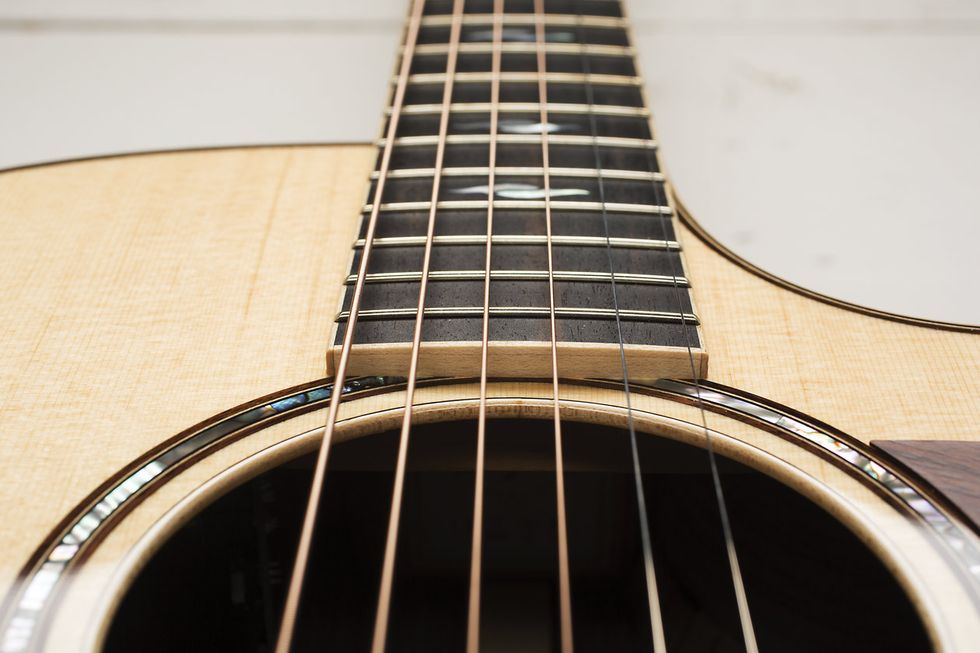Of all the details that distinguish one guitar from another, the geometry of a fretboard seems to be nearly invisible on a specification list. It’s usually just listed as a radius number. While we might glance over the measurements, most players will simply wrap their hand around the neck and see if it fits. In an era when more and more guitars are bought and sold in settings where players don’t have the chance to feel how a neck sits in their hands, however, it helps to know what information a fretboard radius can tell you about a guitar’s feel.
For a long time, guitars and other fretted instruments featured fretboards with a totally flat profile. When plucking strings, our fingers tend to have the easiest striking motion if the strings are on the same plane. A player’s fingertips or nails seem to know where the strings are, and that encourages accurate and effortless articulation. But looking at the fretting hand tells a different story. Pressing down individual notes with our fingertips may be easy enough, but try extending the fingers into the perfectly straight line required to execute a full barre chord. That takes effort. And effort inhibits dexterity. The fretting hand has a much easier time if allowed to relax and form a shallow arch.
In the world of gut-string (and later nylon-string) guitars, the compromise between the effort of the articulation hand and fretting hand found a happy balance with a flat fretboard. The low-tension strings were easy enough to fret clearly, and the picking hand enjoyed a uniform string level to assist in the multi-string, counterpoint-laden melodies required by much of the guitar’s repertoire. The necks were fairly broad and allowed plenty of space between the relatively thick but flexible strings to fret individual notes without bumping into adjacent strings.
As steel strings were adopted into the guitar’s development, the balance between hands needed to change since those higher-tension metal strings were harder to push down. Arching the fretboard was an easy decision to make. When the plane of the strings is adjusted to fit over a rounded fretboard, the middle strings are pushed toward the fretting fingers, thereby requiring less effort to fret clean notes. Simultaneously, the guitar was adopting more of a rhythmic role, with players using a pick and strumming chords. Since that playing style didn’t require as much string-height sensitivity in the strumming hand, a new, happy balance was established.
The eventual adoption of electric guitar playing brought more expressiveness to the fretting hand. With their guitars electrically amplified and using smaller string sizes, more players included wider varieties of vibrato and string-bending effects into their music, but also discovered that a highly arched fretboard posed some limitations. As a string set with low action is bent toward the middle of an arched fretboard, at some point it will run into the fret immediately in front of the one playing the note—thereby choking off the sound.
Moving on to the practical needs of today’s player, builders continue to try to achieve the best-feeling balance between fretting and articulation hands by altering both the arch of a fretboard and the plane of the strings suspended over it, whether using nylon or steel strings. The arch is usually measured and described as part of a circle with a specific radius. So when we see a “12 radius” listed for a fretboard surface, we can translate this into a playing surface shaped to an arched cross-section that perfectly matches a segment taken from a 12" radius, or 24" diameter circle. That visual perspective makes it easier to understand a smaller number—like the 7 1/4" radius of an early Telecaster—reflects an extremely curved surface, while a 20" radius represents a nearly flat fretboard with only a tiny bit of arch.
Translating measurements into feelings is inexact at best, but a few generalizations can be made. A heavily arched fretboard tends to be easy to fret clearly. Barre chords are easier to play and don’t cause much fatigue, but it comes at the expense of having to push strings uphill when trying to bend a note. Flatter fretboards tend to make strings feel slinky and easier to bend (as well as encourage more accurate fingerpicking), but they can make it more difficult to cleanly press down some chord shapes. Most guitars tend to fall toward the middle of the spectrum as a fair compromise.
The next time you wrap your hands around your favorite guitar, take a moment to examine the neck you’ve spent so much time with. Seeing the detail carefully designed into the playing field can help you understand what you like about what you feel there.













![Rig Rundown: Russian Circles’ Mike Sullivan [2025]](https://www.premierguitar.com/media-library/youtube.jpg?id=62303631&width=1245&height=700&quality=70&coordinates=0%2C0%2C0%2C0)





